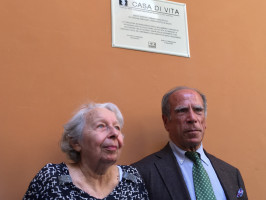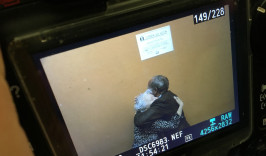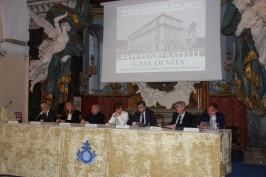Hospital of the Brothers of St. John of God recognized as “House of Life”
 Gabriele Sonnino and Luciana Tedesco, two of the Jews rescued by the Fatebenefratelli hospital, in front of the new commemorative plaque marking the Fatebenefratelli hospital as House of Life. Franco Ilardo.
Gabriele Sonnino and Luciana Tedesco, two of the Jews rescued by the Fatebenefratelli hospital, in front of the new commemorative plaque marking the Fatebenefratelli hospital as House of Life. Franco Ilardo.The name was terrible, but the “K disease” was not a lethal virus. It was the great invention of Professor Giovanni Borromeo and religious of the Hospital of the Brothers of St. John of God, located on the Tiber Island in Rome, to save the lives of dozens of Jews persecuted by the Nazis during World War II.
When the SS entered the hospital, medical and religious explained to the Germans that behind the doors of two special wards, there were patients suffering from this terrible disease, some terminally ill. The officers did not dare to open the doors.
If they did, they would have met with Jewish families. In one room, men, on the other, women and children.
To remember this singular feat of creativity and courage, the Raoul Wallenberg Foundation bestowed, on June 21, upon the hospital, one of the oldest and renowned in the Eternal City, the prestigious recognition of “House of Life”.
In the courtyard of the hospital a plaque was placed in the presence of the highest representatives of the Jewish community of Rome, in particular its president, Ruth Dureghello; the vice president of the hospital, brother Giampiero Luzzatto; the President of the Shoah Foundation Museum of Rome, Mario Venezia; as well as religious and hospital executives.
The emotion clouded the eyes of many of those present when Luciana Tedesco spoke. She was a child of ten during the German occupation. The hospital saved her life and the lives of her entire family .
“I think that there was no patient in this hospital,” Luciana, now 83, said with a smile on her face. “All the people I saw were healthy. We were refugees who found a home here.”
During the ceremony the Polish religious Maurizio Bialek was remembered, head of this community of the Order of St. John of God, who set up a clandestine radio station in the basement of the hospital, which was in continuous contact with the partisans of Rome and the region. The religious gave the false sick documents and alternative shelters in monasteries of the Italian capital.
Professor Borromeo, a highly prestigious doctor at the time, had a good sense of humor, and baptized the illness of his invention with the letter “K”, the initial of the last name of a Nazi officer in Rome, Herbert Kappler. “K” was also the first letter of the the infamous General Albert Kesselring, stationed in Rome.
At the ceremony also another survivor attended, Gabriele Sonnino, who entered the hospital on October 16, 1943, at the age of four: “There were kids my age -states to Aleteia.org-. We could not do anything all day, and did not know why we were locked up there. We felt it was a punishment. Today we know it was salvation. ”
With tears in his eyes Gabriele recalled brother Mauricio Bialek: “It was my second father. I owe him my life. ”
The plaque that from now on will be seen by thousands who daily cross the courtyard of the hospital, states: “This place was a beacon of light in the darkness of the Holocaust. It is our moral duty to remember these great heroes for new generations to recognize and appreciate them.”
Translation: IRWF


